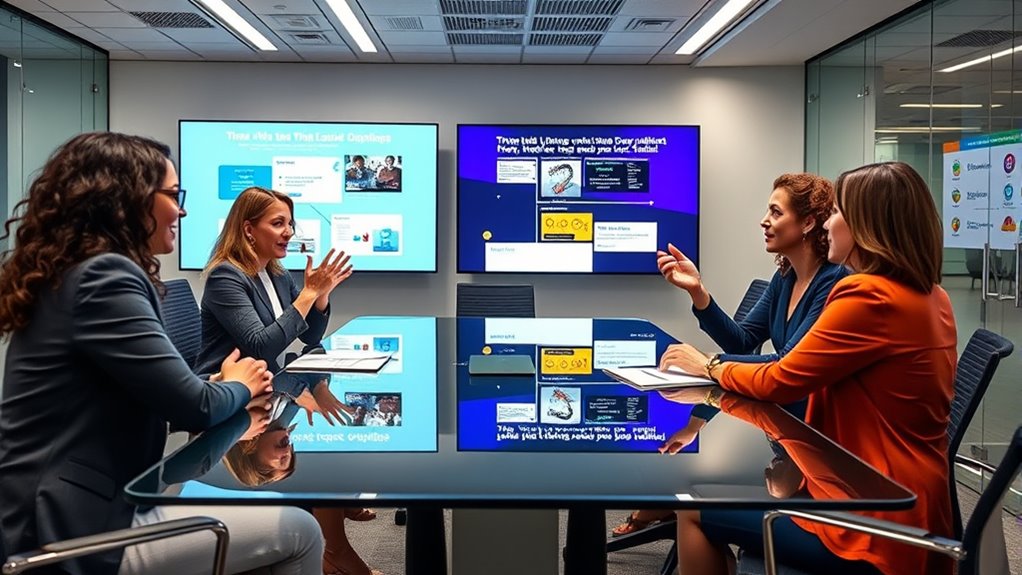Deaf professionals are breaking barriers and rising into leadership roles worldwide by using resilient strategies, leveraging technology, and advocating for inclusion. They challenge stereotypes, foster accessibility, and create diverse workplaces. Mentorship, networking, and proactive communication help them succeed despite societal misconceptions. The use of sign language apps, captioning tools, and assistive tech further empowers them. Keep exploring how these innovations and strategies continue to transform opportunities for Deaf leaders everywhere.
Key Takeaways
- Deaf professionals are overcoming communication barriers through innovative technologies and accessible communication tools.
- Mentorship programs and networking strategies support Deaf individuals in leadership development.
- Inclusive workplace policies and accommodations foster opportunities for Deaf professionals to advance.
- Increasing societal awareness and recognition of sign language empower Deaf leaders and promote representation.
- Technological advancements and advocacy efforts are driving greater inclusion and breaking stereotypes in leadership roles.
Pioneering Leaders: Profiles of Influential Deaf Professionals

Have you ever wondered how deaf professionals have broken barriers and reshaped industries? Many influential deaf leaders credit their success to mastering sign language, which enables direct communication and authentic connection. These pioneers often participate in mentorship programs, both as mentees and mentors, fostering growth and inspiring others to pursue leadership roles. Their stories showcase resilience, innovation, and a commitment to inclusivity. For example, some have founded organizations that advocate for workplace accessibility, while others serve on boards shaping policy. Their visibility challenges stereotypes and demonstrates that deaf professionals can excel in any industry. By leveraging sign language and mentorship programs, they break down communication barriers and pave the way for future generations to rise confidently into leadership positions. Additionally, understanding the role of assistive communication tools can further support their success in diverse environments.
Overcoming Challenges: Strategies for Success in the Corporate World

Steering the corporate world as a deaf professional requires strategic planning and resilience, especially when facing communication barriers and misconceptions. To succeed, leverage mentorship programs to gain guidance and build confidence. Developing effective networking strategies helps you connect with influential peers and leaders, expanding your opportunities. Stay proactive by advocating for your needs and demonstrating your expertise. Embrace continuous learning to stay ahead in your field. Focus on clear, direct communication to overcome misunderstandings. Additionally, surround yourself with supportive colleagues who value diversity. Recognizing that visual tools like visual communication can enhance understanding is also beneficial. Utilizing accessible communication methods ensures your messages are effectively conveyed. Incorporating self-watering plant pots as a metaphor can remind you of the importance of nurturing your professional growth over time. Building awareness of privacy policies related to your online presence can help protect your personal information and foster trust. Developing skills in textile line techniques can also open new avenues for creative expression and professional development. Recognize that persistence is key—challenges can be turned into opportunities for growth. By combining these strategies, you’ll break down barriers and position yourself for leadership success. Remember, resilience and resourcefulness are your greatest tools in navigating the corporate landscape.
The Role of Technology in Enhancing Accessibility and Communication

Technology plays a crucial role in breaking down communication barriers for deaf professionals by providing innovative tools that enhance accessibility. Sign language apps and real-time captioning software allow you to communicate more effectively in meetings and daily interactions. Assistive tech, like video relay services, connects you with colleagues or clients via sign language interpreters instantly. These tools give you independence and confidence, reducing reliance on others for communication support. By integrating advanced technology into your work environment, you can participate fully and showcase your leadership potential. As technology continues to evolve, it will further empower you to overcome barriers, ensuring your voice is heard and your skills recognized. Embracing digital sound synthesis can also facilitate more inclusive communication methods by creating customized auditory cues and feedback. Staying updated on these innovations is essential for maximizing your professional growth and leveraging assistive technologies that support your communication needs. Additionally, understanding the trustworthiness of AI models can help you advocate for ethical and reliable tech solutions in your workplace. Recognizing how high refresh rates contribute to seamless real-time interactions can further improve your engagement with these tools. Furthermore, awareness of credit card security measures can help you navigate digital transactions confidently and securely.
Building Inclusive Workplaces: Best Practices and Policy Changes

Building an inclusive workplace requires more than just implementing technology; it involves adopting best practices and policy changes that foster equity and respect. You should prioritize thorough workplace accommodations, ensuring Deaf professionals have the tools and support needed to succeed. Implementing regular diversity training helps educate staff about accessibility and cultural competence, promoting understanding and collaboration. Establish clear policies that protect against discrimination and encourage open communication. Additionally, creating feedback channels allows employees to voice concerns and suggest improvements. These steps demonstrate your commitment to inclusivity and help break down barriers, empowering Deaf professionals to thrive in leadership roles. Emphasizing continuous learning and adaptation ensures your workplace remains equitable and welcoming for all employees. Recognizing and adjusting to store hours can also improve organizational flexibility and responsiveness to employee needs. Incorporating accessibility standards into your policies can further enhance inclusivity and ensure consistent support for Deaf professionals.
Future Outlook: Emerging Trends and Opportunities for Deaf Leaders

As awareness of diversity and inclusion continues to grow, emerging trends are opening new pathways for Deaf leaders to influence their fields. Technology advancements, like real-time sign language translation, enhance communication and accessibility. Mentorship programs tailored for Deaf professionals foster skill development and leadership growth. Additionally, increased recognition of sign language as an essential communication tool empowers Deaf leaders to shape policies and organizational culture. The future offers promising opportunities to expand representation and influence. Consider the following trends shaping this landscape:
| Trend | Impact | Example |
|---|---|---|
| Sign language technology | Improves communication and inclusion | Real-time translation apps |
| Mentorship programs | Builds leadership skills | Deaf leadership networks |
| Policy advocacy | Strengthens rights and recognition | Inclusive workplace laws |
Furthermore, advancements in sign language recognition and standardization are laying a solid foundation for greater acceptance and integration across various sectors. Ongoing efforts to standardize sign language facilitate consistent communication and understanding, further empowering Deaf professionals in leadership roles. These technological and policy developments are crucial for creating a more inclusive environment where Deaf voices can thrive and lead effectively.
Frequently Asked Questions
How Do Deaf Professionals Navigate Workplace Biases and Stereotypes?
When facing workplace biases and stereotypes, you actively break down communication barriers by advocating for accessibility solutions like sign language interpreters or captioning. You demonstrate your skills and expertise confidently, showing that your deafness doesn’t define your abilities. By staying persistent and educating colleagues, you foster understanding and challenge misconceptions. Your proactive approach helps create an inclusive environment where your leadership potential shines, inspiring others to overcome similar obstacles.
What Mentorship Programs Support Deaf Individuals in Leadership Development?
Like Athena’s wisdom guiding heroes, mentorship programs empower deaf individuals in leadership. You can seek out initiatives that offer peer support and sign language training, helping you build confidence and skills. Programs such as the National Deaf Leadership Program or local mentorship groups connect you with experienced mentors who understand your journey. These programs foster growth, break down barriers, and help you rise to leadership with strength and resilience.
How Do Cultural Differences Impact Deaf Professionals’ Career Progression Worldwide?
You might notice that cultural perceptions deeply influence deaf professionals’ career growth worldwide. Some cultures view deafness negatively, creating communication barriers that hinder opportunities and leadership chances. In contrast, others embrace diversity, fostering inclusive environments. These differences impact how deaf professionals are perceived and supported in their careers. Understanding and addressing these cultural perceptions and communication barriers is essential to promoting equal leadership opportunities for deaf individuals globally.
What Funding or Grants Are Available for Deaf-Led Initiatives?
You can find funding and grants for deaf-led initiatives through organizations that support accessible technology and community advocacy. Look into government grants, nonprofit programs, and private foundations dedicated to promoting inclusivity. These sources often prioritize projects that enhance communication access and empower deaf communities. By applying for these funds, you help advance deaf professionals’ leadership and foster a more inclusive environment, making a meaningful impact on your community.
How Can Organizations Measure Success in Diversity and Inclusion for Deaf Employees?
You might think measuring success in diversity and inclusion for deaf employees is complex, but focusing on accessible metrics makes it straightforward. By tracking employee engagement through surveys and feedback, you can gauge how supported they feel. Additionally, monitoring accessibility metrics—like the availability of sign language interpreters or captioned meetings—helps you see if your workplace truly fosters inclusion. These tools keep you aware of progress and areas needing improvement.
Conclusion
As you see, deaf professionals are breaking barriers and leading the way. Did you know that companies with inclusive policies see a 23% higher profit margin? By embracing accessibility and fostering diverse leadership, you can help create a more equitable workplace. Your support and awareness can empower more deaf professionals to rise to leadership roles, shaping a future where talent knows no barriers. Together, we can make inclusion the norm, not the exception.











